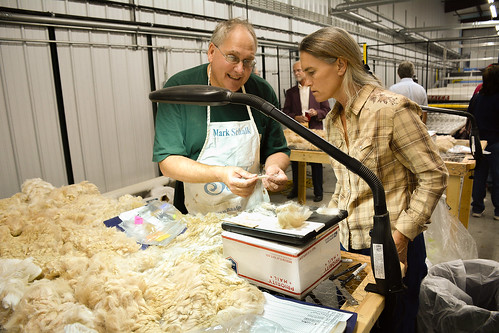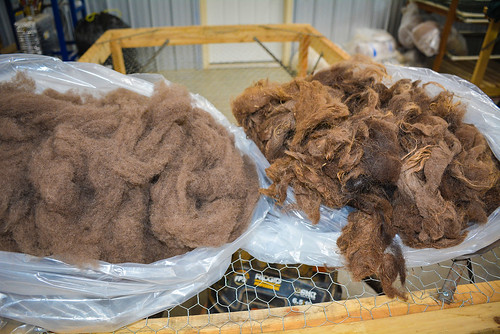
Mark Schalk explains the process for sorting Alpaca hair that will be used to make blanket yarn. Schalk is the owner of Two Branch Ranch, an Alpaca farm in Saline, Mich. He brought the fiber to Springfield, Ky., for sorting and cleaning.
October is National Cooperative Month, and we’re happy to spotlight several projects throughout the month that have been supported through USDA Rural Development’s Cooperative Services.
It took nearly two years to travel from Italy to America via transportation across water, through the air, and along roadways and railways – and now a large, brightly colored piece of equipment is making history in the tiny rural community of Springfield, Ky.
But this is no ordinary piece of hardware. It is a technically advanced dehairing machine that is unique for a variety of reasons. The machine is one of only four in existence in the world; it is touted as one of the most powerful, sophisticated dehairing machines available; and it will greatly reduce the time and cost required to prepare American natural fibers for processing into luxury yarns that will be used to make textiles.
Natural Fiber Producers cooperative – which is comprised of 318 producers of all types of animal fibers, primarily alpaca, llama, and sheep – invested their own money to make the down payment for the equipment. NFP worked with USDA to obtain a Business and Industry Loan Guarantee with financing from Springfield State Bank, in addition to the Kentucky Agricultural Finance Corporation,
The dehairing machine is operating it in a 12,000-square-foot facility owned by U.S. Natural Fibers. It occupies 500 square feet of floor space and can process between 20-65 pounds of fiber per hour.
USDA Rural Development staff joined members of NFP cooperative from across the country for a grand opening and ribbon cutting celebration on Sept. 17, 2015.
A large crowd turned out to celebrate this monumental 2-day event because of its significance in creating more textile jobs in the United States. NFP President Brian Willsey said this machine greatly improves fibers for use in luxury textiles and reinforces the growth of “Made in America” and “Buy Local” campaigns.

Bison hair after processing through the dehairing machine (l) and the raw bison hair (r).
For more than three decades, luxury fiber producers lacked access to the dehairing process, which meant they, along with U.S. textile manufacturers, had to outsource their processing overseas.
With the purchase of this equipment, producers will save time and money by shipping raw fiber to the Kentucky plant and having it processed into soft, usable fiber.
No comments:
Post a Comment
Note: Only a member of this blog may post a comment.